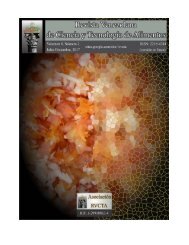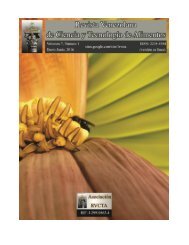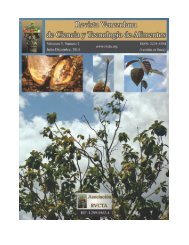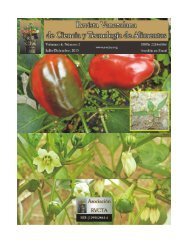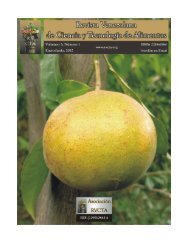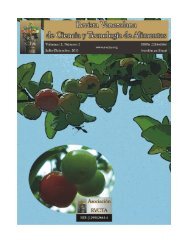RVCTA Volumen 5 - Número 1
Create successful ePaper yourself
Turn your PDF publications into a flip-book with our unique Google optimized e-Paper software.
058 Rev. Venez. Cienc. Tecnol. Aliment. 5(1):057-069.<br />
resultados, se decidió utilizar la combinación de 2 U de GOX y 2,0 % de glucosa para agregarlos como<br />
aditivos en la leche y se establecieron dos sistemas: GOX/G sin pasteurizar y GOX/G pasteurizado. El<br />
crecimiento fue monitoreado por la técnica de contaje de colonias en placa-agar, a partir de 1 mL de<br />
cultivo a las 4, 6 y 24 h de incubación. Se encontró que los sistemas con GOX hasta las 6 horas<br />
presentaron efectos similares, inhibiendo significativamente el crecimiento de la bacteria, mientras que<br />
a las 24 h ya no se observó dicha inhibición, pero sí que el sistema con GOX pasteurizada exhibió una<br />
población menor que el sistema GOX sin pasteurizar. Estos hallazgos proyectan a la enzima GOX<br />
como una alternativa para la conservación de la leche, tanto cruda como pasteurizada.<br />
Palabras claves: Escherichia coli, glucosa oxidasa, leche, pasteurización.<br />
Abstract<br />
Milk is one of the most important foods to be rich in nutrients and that is the raw material for<br />
the manufacture of a wide range of products. It has been shown that pasteurized milks trademarks, may<br />
have post-processing contamination, which poses a risk to public health. That is why in recent decades<br />
has gained importance the use of synthetic or organic additives as a complementary technique during<br />
food processing. Glucose oxidase (GOX) enzyme has wide application in the food industry due to its<br />
antioxidant and antimicrobial properties. Additionally, it has demonstrated its ability to inhibit the<br />
growth of different enterobacteria. Therefore, this work proposed adding the enzyme GOX in milk and<br />
evaluates its effect on the growth of a strain of Escherichia coli ATCC 25922. The GOX and glucose<br />
concentration that caused inhibition of bacterial growth in Luria-Bertani medium was standardized and<br />
depending on the results, it was decided to use the combination of 2 U of GOX and 2.0 % glucose as<br />
additives to add in the milk and two systems were developed: GOX/G unpasteurized and pasteurized<br />
GOX/G. Growth was monitored by the technique of colony counting on agar plate, starting from 1 mL<br />
of culture at 4, 6 and 24 h of incubation. It was found that systems with GOX to 6 hours had similar<br />
effects, significantly inhibit the growth of bacteria, while at 24 hours, this inhibition was not observed,<br />
but the system pasteurized GOX exhibited a smaller population than the GOX system unpasteurized.<br />
These findings GOX enzyme projected as an alternative to the preservation of milk, both raw and<br />
pasteurized.<br />
Key words: Escherichia coli, glucose oxidase, milk, pasteurization.<br />
INTRODUCCIÓN<br />
Por su aporte nutricional, la leche es uno<br />
de los alimentos de mayor importancia en<br />
muchos países del mundo (Celis y Juárez,<br />
2009). Además de ser un alimento rico en<br />
nutrientes, constituye la materia prima para la<br />
elaboración de una amplia gama de productos<br />
(Díaz, 2000). No obstante, es un alimento<br />
altamente perecedero, por lo que debe ser<br />
manejado de manera adecuada. Las condiciones<br />
de higiene y sanidad de las explotaciones<br />
lecheras, así como a nivel de las industrias<br />
procesadoras, deben ser óptimas para garantizar<br />
la calidad microbiológica de este alimento<br />
(Valbuena et al., 2004; Celis y Juárez, 2009).<br />
En Venezuela, la norma 798:1994 de la<br />
Comisión Venezolana de Normas Industriales<br />
(COVENIN), define la leche pasteurizada como<br />
“…la leche cruda homogeneizada o no, que ha




